 W
WWorld War I is remembered and commemorated by various war memorials, including civic memorials, larger national monuments, war cemeteries, private memorials and a range of utilitarian designs such as halls and parks, dedicated to remembering those involved in the conflict. Huge numbers of memorials were built in the 1920s and 1930s, with around 176,000 erected in France alone. This was a new social phenomenon and marked a major cultural shift in how nations commemorated conflicts. Interest in World War I and its memorials faded after World War II, and did not increase again until the 1980s and 1990s, which saw the renovation of many existing memorials and the opening of new sites. Visitor numbers at many memorials increased significantly, while major national and civic memorials continue to be used for annual ceremonies remembering the war.
 W
WWar memorials were erected in many towns of Queensland, Australia, in commemoration of the service and death of many Queenslanders in World War I.
 W
WThe 22 July Circle is a traffic circle in Thailand. It's an intersection of Maitri Chit, Santiphap and Mittraphan roads in Pom Prap subdistrict, Pom Prap Sattru Phai district, Bangkok.
 W
WThe American War Memorial is a World War I memorial in the British Overseas Territory of Gibraltar. It was built for the American Battle Monuments Commission in 1933, and incorporated into the main city wall, the Line Wall Curtain. It commemorated the successful alliance of the United States and the United Kingdom in their naval exploits in the vicinity of Gibraltar during the Great War. The monument was inaugurated in 1937. Sixty-one years later, in November 1998, the monument was the site of another unveiling ceremony, that of a bronze plaque which commemorated the World War II Allied invasion of North Africa, Operation Torch. That unveiling ceremony was one of a number of events that weekend whose guests included dignitaries from the United Kingdom and the United States.
 W
WAmerican War Memorials Overseas (AWMO) was founded in 2008 and is a non-profit corporation working to document, promote, and preserve non-government supported War Memorials honoring Americans outside of the United States. American War Memorials Overseas is a 501(c)(3) nonprofit corporation and as such is entirely dependent on donated funds.
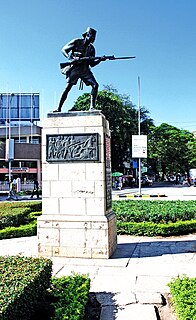 W
WThe Askari Monument or Dar es Salaam African Memorial in Dar es Salaam, Tanzania, is a memorial to the askari who fought in the British campaign against the German Army in East Africa in World War I. It was unveiled in 1927. The monument is located at the centre of a roundabout on Samora Avenue at the perpendicular junction to Maktaba Street and Azikiwe Street, a place that reportedly also marks the exact centre of downtown Dar es Salaam.
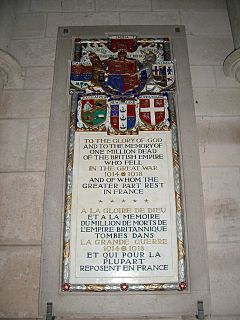 W
WBetween 1923 and 1936, the Imperial War Graves Commission erected a series of memorial tablets in French and Belgian cathedrals to commemorate the British Empire dead of the First World War. The tablets were erected in towns in which British Army or Empire troops had been quartered.
 W
WThe Canadian Battlefield Memorials Restoration Project was a C$30-million Government of Canada capital project that aimed to restore and rehabilitate Canada's memorial sites in France and Belgium, in order to maintain and present them in a respectful and dignified manner.
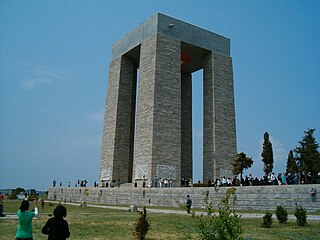 W
WThe Çanakkale Martyrs' Memorial is a war memorial commemorating the service of about 253,000 Turkish soldiers who participated at the Battle of Gallipoli, which took place from April 1915 to December 1915 during the First World War. It is located within the Gallipoli Peninsula Historical National Park on Hisarlık Hill in Morto Bay at the southern end of the Gallipoli peninsula in Çanakkale Province, Turkey.
 W
WThe Carmel-by-the-Sea World War I Memorial Arch is a World War I memorial designed in 1919 by architect Charles Sumner Green and located at Ocean Avenue and San Carlos Street center median divider in Carmel-by-the-Sea, California. The Memorial Arch has been a historic landmark since November 1921, when it was built by World War I veterans. The Spanish Mission Revival style arch is constructed of Carmel sandstone.
 W
WA cenotaph is an empty tomb or a monument erected in honour of a person or group of people whose remains are elsewhere. It can also be the initial tomb for a person who has since been reinterred elsewhere. Although the vast majority of cenotaphs honour individuals, many noted cenotaphs are instead dedicated to the memories of groups of individuals, such as the lost soldiers of a country or of an empire.
 W
WThe Cenotaph War Memorial in Viharamahadevi Park, Colombo, Sri Lanka is a war memorial dedicated to the military personnel from Ceylon killed in action during the two world wars. It comprises a towering Cenotaph and Memorial Walls. The foundation stone was laid by Brigadier General Sir William Henry Manning, Governor of Ceylon on December 7, 1921 and was unveiled by him October 27, 1923 at the Galle Face Green and was known as the Victory tower. It was dismantled and re-erected at Victoria Park, during World War II after fears that the Japanese might use it as a marker to direct their artillery. The Cenotaph contains the names of those killed in the Great War, while the Memorial Wall behind it maintains the names of those killed in the Second World War. A single woman, Miss L. Midwood is listed among the dead of the Great War.
 W
WThe Cenotaph is a war memorial on Heerengracht Street in Cape Town. The city's annual Remembrance Day ceremonies are held there. It is classified as a public memorial and as such is subject to protection in terms of heritage legislation administered by Heritage Western Cape, the provincial heritage resources authority of the Western Cape province of South Africa.
 W
WThe Cenotaph was erected in Farewell Square, Durban, South Africa, as a war memorial to soldiers who died in World War I.
 W
WThe Cenotaph, also known as Penang War Memorial, is a cenotaph located at the Esplanade in George Town, Penang, Malaysia. The site of the Cenopath is situated at the shoreline of the Esplanade, at Jalan Tun Syed Sheh Barakbah and Jalan Padang Kota Lama, by the padang and the City Hall that it fronts.
 W
WThe Cenotaph is a war memorial located within the Esplanade Park at Connaught Drive, within the Central Area in Singapore's central business district.
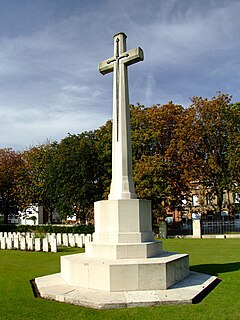 W
WThe Cross of Sacrifice is a Commonwealth war memorial designed in 1918 by Sir Reginald Blomfield for the Imperial War Graves Commission. It is present in Commonwealth war cemeteries containing 40 or more graves. Its shape is an elongated Latin cross with proportions more typical of the Celtic cross, with the shaft and crossarm octagonal in section. It ranges in height from 18 to 24 feet. A bronze longsword, blade down, is affixed to the front of the cross. It is usually mounted on an octagonal base. It may be freestanding or incorporated into other cemetery features. The Cross of Sacrifice is widely praised, widely imitated, and the archetypal British war memorial. It is the most imitated of Commonwealth war memorials, and duplicates and imitations have been used around the world.
 W
WThe Dover Patrol Monuments are a trio of war memorials designed by Sir Aston Webb to commemorate the Royal Navy's Dover Patrol of the First World War. Two identical granite memorial obelisks, 75 feet (23 m) high, were erected near Dover and on the Cap Blanc-Nez near Calais in 1921 and 1922. A third was erected in Brooklyn, New York, in 1931. The UK monument became a Grade II listed building in August 1966, promoted to Grade II* in August 2015.
 W
WThe Dury Memorial is a World War I Canadian war memorial that commemorates the actions of the Canadian Corps in the Second Battle of Arras, particularly their breakthrough at the Drocourt–Quéant Line switch of the Hindenburg Line just south of the town of Dury, Pas-de-Calais, France.
 W
WThe Gibraltar War Memorial is a First World War monument located on Line Wall Road in the British Overseas Territory of Gibraltar. Also known as the British War Memorial, it was sculpted by Jose Piquet Catoli of Spain and unveiled in 1923. Adjacent to the monument on the esplanade built in 1921 are several memorial tablets, as well as two Russian guns from the Crimean War.
 W
WMemorial and Museum of Martyred Turks Massacred by Armenians or Iğdır Genocide Memorial and Museum is a memorial-museum complex to commemorate alleged massacres of Turks by Armenians during World War I and the Turkish–Armenian War. The construction for the memorial started on 1 August 1997 and it was dedicated on 5 October 1999 in Iğdır, Turkey. Its height is 43.5 metres, making it the tallest monument in Turkey.
 W
WL’Anneau de la Mémoire is a World War I memorial in Ablain-Saint-Nazaire, France. Designed by Philippe Prost and inaugurated on November 11, 2014, the 96th anniversary of Armistice Day, the memorial honors the 576,606 soldiers of forty different nationalities who died at Nord-Pas-de-Calais. The memorial is located at the site of the national cemetery of Notre-Dame-de-Lorette. The monument consists of 500 metal panels that are arranged in an ellipse pattern, each 3 meters in height. Each panel contains approximately 1200 names of fallen soldiers, listed alphabetically by last name. The 500th panel remains blank so that any newly discovered names may be inscribed. The most noteworthy aspect of the Ring of Memory is that it is the first memorial to list alphabetically, with no regard to rank nor nationality.
 W
WThe Lochnagar mine south of the village of La Boisselle in the Somme département was an underground explosive charge, secretly planted by the British during the First World War, to be ready for 1 July 1916, the first day on the Somme. The mine was dug by the Tunnelling Companies of the Royal Engineers under a German field fortification known as Schwabenhöhe.
 W
WThe Mausoleum of Yugoslav Soldiers is a neoclassical chapel with an ossuary containing remains of Yugoslav soldiers killed in the First World War. It was built in 1926 in Bezruč Park in Olomouc, Czechoslovakia by the Czechoslovak-Yugoslav League. The designer of the chapel was architect Hubert Aust. The mausoleum was owned by Yugoslavia until its breakup. Today it is damaged but renovation has been prevented because of unclear property rights.
 W
WMemorial Ossuary Cer was built in the village Tekeriš on the mountain Cer. The remains of the killed Serbian soldiers after the Battle of Cer in World War I were buried there. Memorial ossuary Cer is on the list of Immovable Cultural Heritage of Exceptional Importance.
 W
WThe military memorial of Monte Grappa is the largest Italian military ossuary of the First World War. It is located on the summit of Monte Grappa between the provinces of Treviso and Vicenza, at 1,776 meters above sea level. Access to the memorial is Strada Cadorna, built by the army on the orders of General Luigi Cadorna to bring construction materials for the fortification on Monte Grappa in 1917.
 W
WThe Monroe County Courthouse in Madisonville, Tennessee was built in 1897. It was listed on the National Register of Historic Places in 1995.
 W
WThe Monument to the Unknown Hero is a World War I memorial located atop Mount Avala, south-east of Belgrade, Serbia, and designed by the sculptor Ivan Meštrović. The memorial was built in 1934-1938 on the place where an unknown Serbian World War I soldier was buried. It is similar to many other tombs of the unknown soldier built by the allies after the war. The Žrnov fortress was previously located on the same place.
 W
WThe North Carolina State University Memorial Belltower is a 115-foot-tall (35 m) free-standing bell tower on the Main Campus of North Carolina State University in Raleigh, North Carolina Conceived as a war memorial to honor university alumni killed in World War I and the university's overall participation in the conflict, the Belltower now serves as a perpetual memorial for N.C. State students and alumni who gave their lives in the service of the nation. A prominent university symbol, the tower is a popular rallying point for the campus community.
 W
WThe obelisk at Prague Castle is a granite monolith and World War I memorial designed by Jože Plečnik, installed at Prague Castle in Prague, Czech Republic. It stands 16 meters high. It is located in the Third Castle Courtyard.
 W
WThe Oslavia War Memorial is an Italian monument to soldiers who fell in battle during the battles of the Isonzo, particularly those who died during the taking of Gorizia in 1916. It stands on a 150m hill in the village Oslavia, on the outskirts of Gorizia. The hilltop was on the front line as Austro-Hungarian troops defended the salient around Gorizia during the first, third and fourth battles of the Isonzo.
 W
WThe Port Tewfik Memorial was originally situated at Port Tewfik, now called Suez Port, on the Suez Canal. It was unveiled in May 1926 for the Imperial War Graves Commission and commemorated 4,000 officers and men of the Indian Army killed during the Sinai and Palestine Campaign during the First World War. The original memorial was designed by Scottish architects John James Burnet and Thomas S. Tait, and included sculptures by British sculptor Charles Sargeant Jagger.
 W
WRamleh Commonwealth War Graves Commission Cemetery and Memorial to the Missing is for personnel of both World Wars and the period of Mandatory Palestine. It is located in the town of Ramla in Israel.
 W
WThe Russian Chapel on the Vršič Pass is a Russian Orthodox chapel located on the Russian Road on the northern side of the Vršič Pass in northwestern Slovenia. The chapel, dedicated to Saint Vladimir, was built by Russian prisoners of war engaged in forced labor in the area during World War I. It serves as both a war memorial and a symbolic link between Slovenia and Russia.
 W
WThe Soldiers and Sailors Memorial Gymnasium, on the campus of Union College in Barbourville, Kentucky, was listed on the National Register of Historic Places in 1984.
 W
WSpectra is the name of a series of art installations by Ryoji Ikeda which use intense white light as a sculptural material. The most recent presentation of spectra was in Hobart, Tasmania, Australia for four days ending 24 June, 2018 to mark the winter solstice, and as an installation piece at the Dark Mofo festival held by MONA. spectra [Amsterdam] was the first presentation of the work in 2008 its current form; an array of xenon lamps pointed skywards lit from dusk till dawn accompanied by a mathematically derived score audible from each of the lamp bases. The work was first commissioned and produced by Forma Arts.
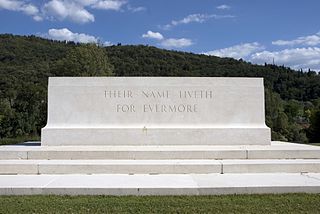 W
WThe Stone of Remembrance was designed by the British architect Sir Edwin Lutyens for the Imperial War Graves Commission (IWGC). It was designed to commemorate the dead of World War I, to be used in IWGC war cemeteries containing 1,000 or more graves, or at memorial sites commemorating more than 1,000 war dead. Hundreds were erected following World War I, and it has since been used in cemeteries containing the Commonwealth dead of World War II as well. It is intended to commemorate those "of all faiths and none", and has been described as one of Lutyens' "most important and powerful works", with a "brooding, sentinel-like presence wherever used".
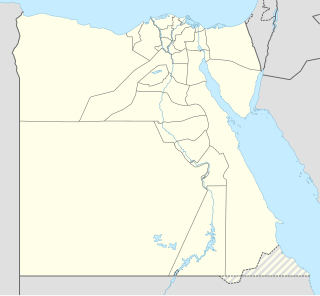 W
WTell El Kebir is 110 km north-north-east of Cairo and 75 kilometres south of Port Said on the edge of the Egyptian desert at the altitude of 29 m. Administratively, it is a part of the Ismailia Governorate.
 W
WThe Italian Charnel House, Kobarid, is an Italian military shrine in Kobarid, Slovenia. Sited on the battlefield of Caporetto, it houses the remains of 7,014 Italians who fell during the battles of the Isonzo.
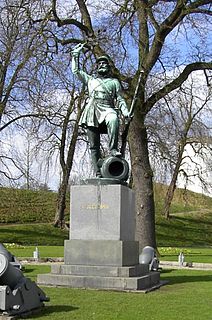 W
WA Tomb of the Unknown Soldier is a monument dedicated to the services of an unknown soldier and to the common memories of all soldiers killed in war. Such tombs can be found in many nations and are usually high-profile national monuments. Throughout history, many soldiers have died in war with their remains being unidentified. Following World War I, a movement arose to commemorate these soldiers with a single tomb, containing the body of one such unidentified soldier.
 W
WThe International Tree of Peace is an international project that originated in Slovakia. The project, created on the occasion of the 100th anniversary of the end of World War I, was initiated by landscape architect Marek Sobola from Žilina, Slovakia. The main goal of the project is to promote a message of peace by planting a Tree of Peace on every continent. The project is claimed to aim at planting trees around the globe to draw awareness to the global environmental issue and to enhance the solidarity of the humankind.
 W
WVictory War Memorial, formerly called the Cupid's bow, is a memorial in Chennai, India, originally constructed to commemorate the victory of the Allied Armies during World War I (1914–1918) and later became the victory war memorial for World War II (1939–1945), erected in the memory of those from the Madras presidency who lost their lives in the wars. Later addition includes inscriptions of 1948 Kashmir Aggression, 1962 War with China and the Indo-Pakistan War.
 W
WWorld War I Eastern Front Cemetery No. 123 in Łużna–Pustki is a soldier's burial place from the time of World War I, located on the Pustki hill.
 W
WThe Y Sap mine was an underground explosive charge, secretly planted by the British during the First World War and ready for 1 July 1916, the first day on the Somme. The mine was dug by the Tunnelling Companies of the Royal Engineers under a German machine-gun nest known as Blinddarm (appendix) in the front line, on the north side of the village of La Boisselle in the Somme département. The mine was named after Y Sap, the British trench from which the gallery was driven. It was one of 19 mines on the British sector to be blown at the start of the battle.
 W
WYsselsteyn German War Cemetery is a military cemetery interring casualties of the First and Second World Wars. It contains over 31,000 soldiers from around 25 countries, including SS-men and Dutch war criminals. This cemetery is located in the village of Ysselsteyn in the municipality of Venray in Limburg, Netherlands, and is 32 km (20 mi) east of Eindhoven. Ysselsteyn is the largest Second World War German cemetery and is the only Nazi-German cemetery in the Netherlands. Following the war, the Nazi soldiers were reburied in the cemetery. The deceased include Germans, Dutch, Poles, and Russians who fought on the side of the Nazis.